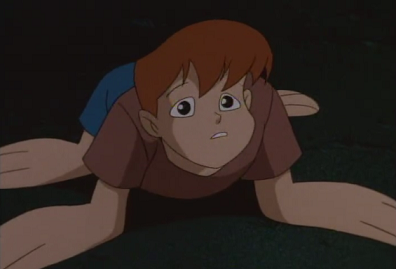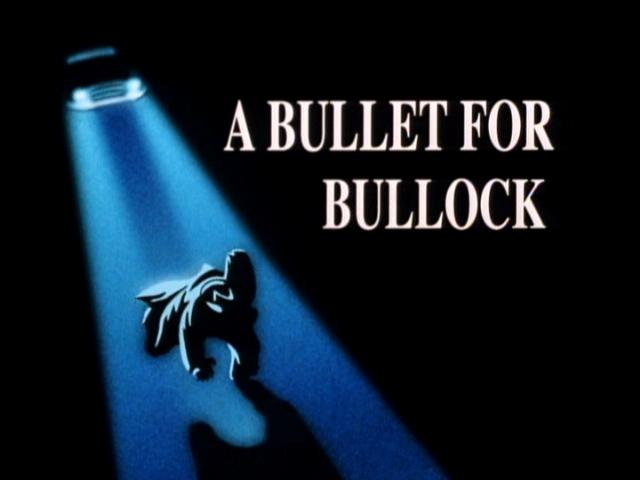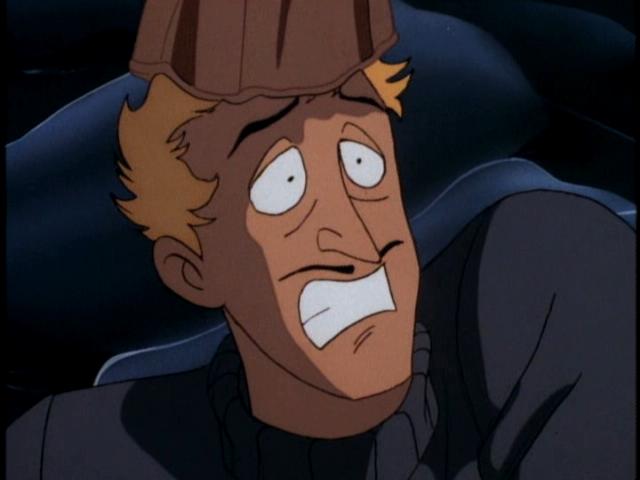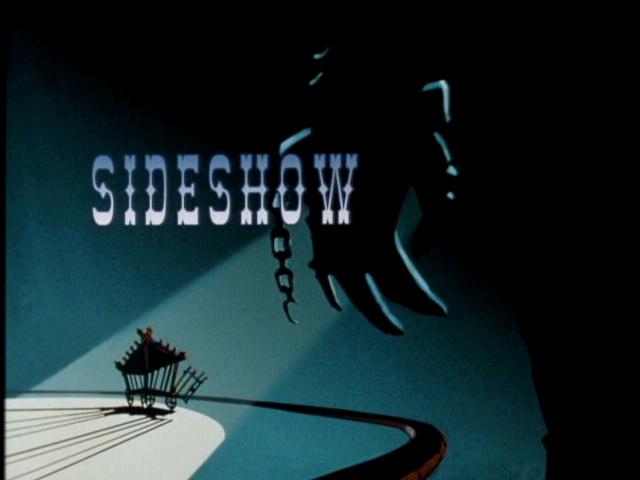“Sideshow”
Story by Michael Reaves
Teleplay by Michael Reaves, Brynne Stephens
Directed by Boyd Kirkland
Episode #066
Music Composed by Michael McCuistion
Animation by Dong Yang Animation Co., LTD.
Original Airdate—May 3rd, 1994
Plot: Killer Croc escapes from police custody and takes refuge in a wilderness sanctuary for retired sideshow performers, who then defend Croc when an injured Batman hunts the killer down.
“Sideshow” is the first of twenty additional episodes FOX Broadcasting ordered for Batman: The Animated Series after the initial order of 65. The additional episodes are distinguished by a) a lack of two-parters (which is great for scheduling double feature reviews), b) a lot of Superman references, as the creators get antsy to start the second DC Animated Universe series, and c) a whole lot more Robin, facilitating a title change to The Adventures of Batman and Robin. Seriously, Robin appears as many times in the next twenty episodes as he does in the previous 65.
The later episodes also represent a subtle time jump forward into the next phase of the ongoing story of Batman and his villains. If phase 1, “Nothing to Fear” to “Vendetta,” is about Batman meeting and defeating most of his rogues gallery for the first time, and phase 2, “Fear of Victory” to “The Worry Men,” is about those criminals returning, this time focused on removing Batman from the picture, phase 3 is about those criminals getting to the point the Penguin reached in “Birds of a Feather,” where they have to face the possibility that they can never beat Batman, and perhaps should retire. The running theme of the next twenty episodes is recidivism: a supervillain is given the chance to reform, and rejects it. And “Sideshow” is a perfect example of “Recidivism, the Animated Series.”
“Sideshow” is based on “A Vow from the Grave” by Denny O’Neil and Neal Adams, first printed in Detective Comics #410 (April, 1971), but instead of a random escaped murderer, Michael Reaves and Brynne Stephens slot in Killer Croc, the Batman villain with a history of being a sideshow attraction. Not counting Batman-in-a-Croc suit in “Almost Got ’Im,” this is the first time seeing Killer Croc since his origin episode, and he’s back to his original characterization: super strong, vicious, and smart. This Croc can manipulate the people around him by playing the innocent. Aron Kincaid does a fantastic job voicing a smart character playing dumb but actually a step ahead of everyone. Yes, in an allusion to “Almost Got ’Im,” Croc tries to kill Batman by throwing a rock at him, but in fairness, the boulder is huge and had the sedative not kicked in at that moment, Batman’s head would be flatter than a pancake. In fact, Croc comes across as one of the most dangerous foes, able to bite through steel, uproot trees with his bare hands, and fight Batman to a standstill over and over and over again.

Croc is one of the least redeemable characters on the show, and yet here redemption comes in the form of Billy the Seal Boy and his giant, anime eyes. Though it’s probable Croc never really considers giving up crime, he does show genuine affection for the adorable moppet. Croc helps out around the farm and runs to help the Goliath fight Batman rather than run away. We, the audience, want Croc to see that he could have a good life here, that maybe the circus folks could convince Batman to leave Croc in peace. But Croc never really tries to reform, instead leaping at the chance to steal $50,000 and tricking his new friends into attacking Batman.
The key line, for this episode and the episodes going forward, is Croc’s non-explanation for his betrayal, “I guess that’s what I was doin’, being myself.” That will be the downfall of each villain given the opportunity to reform going forward. They can be productive members of society, but they cannot do so and still be true to themselves. Croc can only pretend to be an empathetic person for so long before he reverts to greed and vindictiveness. He knows he can get sympathy by sharing his past as a victim of prejudice. (He probably did the same thing to convince a judge he was insane, despite all his actions being totally rational.) But Croc is prejudiced himself, quick to use the term “freak” and “freak show” and accuse the conjoined twins, hunchback, giant, and seal boy of not being human.
“Sideshow” is the only Batman: the Animated Series story that takes place entirely outside of Gotham City. In the real world, outside Gotham, you cannot judge a book by its cover, and atypical bodies can hide wonderful humanity (the best demonstration of this is Kenneth Mars, reusing his King Triton voice for the Shakespeare loving hunchback Richard). No wonder the circus performers are so quick to believe Croc is a victim of prejudice and so generous in their acceptance. Batman doesn’t help matters by saying, “His name is Killer Croc,” as opposed to Croc’s actual name, “Waylon Jones.” But in Gotham, the grotesque are the villains, and if someone looks like a giant crocodile, or man-bat, or wolf, or mudslide, start running. Run fast.

As a sign of things to come, the later episodes had extra time and money in their production, so the animation here rivals the best of any previous episode. Dong Yang masterfully animates the nail-biting fight on top of the train and Batman using the cage he’s locked to fight Croc, as well as small character moments with Billy’s wide-eyed adoration of the crocodile man. They even slip in the first Superman allusion, when Batman, disguised as a reporter, opens up his shirt to reveal his superhero costume underneath.

“A Bullet for Bullock”
Written by Michael Reaves
Directed by Frank Paur
Episode #067
Supervising Composer Shirley Walker
Music by Harvey R. Cohen
Animation Services by Studio Junio
Original Airdate—September 14th, 1995
Plot: Detective Harvey Bullock turns to Batman for help after receiving a series of death threats.
“A Bullet for Bullock” directly adapts Detective Comics #651 (October 1992) by Chuck Dixon and Graham Nolan, making this the first episode based on a comic published after Batman: The Animated Series premiered. Which is a nice sign that the creators of the series continued to look for new sources of inspiration after the show started. As I said with “Vendetta,” I wish this episode, or an episode like this, had happened much earlier in the series. The dynamic between Batman and Bullock is great, and firmly establishing how they feel about each other early would have given emotional context for their many clashes.
Appearances aside, Bullock really is another reflection of Batman—someone who uses extra-legal means in the name of justice—which Bullock and this episode make clear. While Batman tortures a drug dealer for information, Bullock breaks into the offices of a journalist, and we could easily imagine Batman breaking into the office, and Bullock giving a suspect the third degree. They are also both really committed to their own ideas of honor. Bullock is incensed Batman would accuse him of corruption (and he should be after Batman proved he was innocent in “Vendetta”). The biggest difference between them is not Bullock’s slovenly appearance (as Alfred says, he “looks like an unmade bed”) or Batman’s gadgetry. It’s that Bullock is officially sanctioned by the authorities of Gotham, and Bullock has no problem using lethal force when necessary. In some ways, Bullock is Batman, but with a badge and a gun.

The key scene here is when Batman admonishes Bullock not to shoot Vinnie the Shark, but Batman doesn’t need to, because Bullock would rather arrest Vinnie anyway. If Bullock had killed (or tried to kill) Vinnie, he would have slipped into Phantasm-territory, a vigilante Batman would be compelled to stop. As it is, Batman doesn’t mind Bullock using a gun when they partner up to take down Vinnie in the first place. I guess Batman has accepted that the police in Gotham use firearms, and unless he wants to go to war against the entire GCPD, there’s nothing he can do about that.
“A Bullet for Bullock” does a great job of showing that, when he’s not in the unenviable position of competing with Batman, Bullock really is a great cop. He’s a good detective, a fierce interrogator, a surprisingly persuasive manipulator of the press, and in a fight he can more than hold his own. He is, after all, the cop that brought in Killer Croc without Batman’s help, and Killer Croc can bite through steel.
Another way Batman and Bullock are similar is that they are both really abrasive people. The whole plot hinges on the idea that Bullock “steps on a lot of toes,” so many that he cannot narrow down the number of people who’d want to kill him, and Bullock’s messy appearance probably makes him an unpleasant person to be around. Bullock’s standard way of dealing with people is gruff insults, even with people he genuinely likes and respects like Montoya and Gordon. But Batman’s no picnic to work with either. Even though Bullock is reaching out for help (in Bullock’s own grudging, resentful way), Batman responds by yelling at Bullock, accusing him of corruption, and physically manhandling him the entire episode. The final reveal is that Bullock’s rough manners are creating enemies, murderous enemies, beyond the criminals he fights. Bullock starts to understand that he’s making his life worse than it has to be. Batman, who completely fails to see how similar he is to Bullock, never realizes the same thing about himself.
It’d be boring to say this every time, but it’s undeniable here, Robert Costanzo is a wonderful Harvey Bullock. He imbues the character with such great bluster. Usually, Bullock’s so world weary that he’s just genuinely not impressed by anything. Not Batman, not the supervillains, not anything. And then there are episodes like this, where he gets in over his head and suddenly he can be vulnerable and genuinely scared.
Due to the generally grounded nature of the plot, “A Bullet for Bullock” is a fairly gritty, realistic look at crime in a major city, as if this were an episode of NYPD Blue, guest-starring Batman. We watch a drug deal happen and there are explicit mentions of “crack houses.” Security guards get “skanked.” Modern pistols and submachine guns have replaced the usual tommy guns. Bullock lives alone, in squalor (squalor, we learn of his own making). Even the timing of the episode, the week between Christmas and New Year’s, gives the episode a grounded feel. This takes place in a real city, at a real time. As great as Harvey Cohen’s sax heavy blues score is (including a jazzy version of the Batman fanfare), it’s a little out of place. The score should belong to a more traditional film noir-type story, not this rough slice of realism we have.
This is another really beautiful episode. Unlike “Sideshow,” it takes place entirely within Gotham, but it does the same great job of bringing to life the details and quirks that make Gotham seem like a real, live-in place. Studio Junio does an especially great job with Bullock’s “acting,” whether he’s putting on a tough-guy front for Vinnie the Shark, attempting a “charming” face for Summer Gleeson, or just breaking down at the thought of creating his own enemies as he helps a sobbing Nivens off the ground. This episode is a pleasure to watch.

The only really sour note is Nivens, Bullock’s landlord and attempted murderer. The name and pencil-thin mustache imply he’s supposed to be a fussy Brit in the David Niven-mode, but Jeffrey Jones instead plays him as a prissy gay man. The show has been fairly good in avoiding stereotypical characters, so seeing a caricature like this, in an otherwise straightforward episode, is very off-putting.
Steven Padnick is a freelance writer and editor. By day. You can find more of his writing and funny pictures at padnick.tumblr.com.










